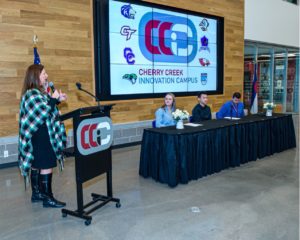Last week, the CareerWise team – along with our partners Pinnacol Assurance and Cherry Creek Schools – was honored to host the USDOL’s Advisory Committee on Apprenticeship (ACA). The goal of the visit was to shine a light on the power of youth apprenticeship, by showing a group of the nation’s leading advocates for traditional apprenticeships what modern youth apprenticeship looks like in action. Site visits and panel discussions with youth apprentices, local employers and educators set the stage for formal committee discussions about policy and resources that will lead to widespread adoption of youth apprenticeship as a talent strategy for employers and as dignified path to career for young people.
The ACA, comprised of employers, labor organizations, and members of the public with representatives from the U.S. Departments of Commerce, Education, Energy, Health and Human Services, Housing and Urban Development, and Transportation serving as ex-officio members, provides advice and recommendations to the Secretary of Labor on ways to better utilize the apprenticeship training model in order to provide equitable career pathways that advance the dignity of work for everyone. Specifically, it’s focused on:
The ACA came to Denver specifically to learn more about the field-leading work that CareerWise has done to demonstrate the transformational power of youth apprenticeship. Visits with key partners allowed them to hear directly from those with whom we have co-created a new vision for pathways to success in our modern American economy.
Cherry Creek Innovation Campus
 The first stop was the Cherry Creek Innovation Campus, a stand-alone college and career preparedness facility accessible to high school students in the Cherry Creek School District. Courses at the CCIC align with the industry standards for seven in-demand and growing career Pathways: Advanced Manufacturing, Business Services, Health & Wellness, Hospitality & Tourism, Infrastructure Engineering, IT & STEAM, and Transportation.
The first stop was the Cherry Creek Innovation Campus, a stand-alone college and career preparedness facility accessible to high school students in the Cherry Creek School District. Courses at the CCIC align with the industry standards for seven in-demand and growing career Pathways: Advanced Manufacturing, Business Services, Health & Wellness, Hospitality & Tourism, Infrastructure Engineering, IT & STEAM, and Transportation.
Sarah Grobbel, Assistant Superintendent, Career, Innovation and Student Engagement for Cherry Creek Schools, emphasized the importance of a comprehensive vision and partnership for these new pathways, noting that success depends on centering the needs and aspirations of all students while letting industry partners lead. As the group toured the center, they remarked on the open layout and the cross-pathway collaboration that the flexible and modern design enables. Grobbel noted the necessity of multiple partners engaging concurrently: educators and students, industry, and intermediaries like CareerWise who can facilitate the connections between the two.
Pinnacol Assurance
 The next stop was Pinnacol Assurance, where the committee members learned about how a large youth apprenticeship program can thrive in a 21st-century industry such as insurance and financial services. The Pinnacol program offers nine different occupations that together Pinnacol and CareerWise have worked with the USDOL to register in the National Registered Apprenticeship system.
The next stop was Pinnacol Assurance, where the committee members learned about how a large youth apprenticeship program can thrive in a 21st-century industry such as insurance and financial services. The Pinnacol program offers nine different occupations that together Pinnacol and CareerWise have worked with the USDOL to register in the National Registered Apprenticeship system.
Pinnacol’s program is a perfect model of the potential for youth apprenticeship at scale to be a true “options multiplier” for both young people and employers. Because Pinnacol hires cohorts of young people and offers multiple occupations, it enables career exploration within the apprenticeship experience, while still providing the portable credentials, debt-free credit, hands-on experience, and perspective that open doors to economic and social mobility. As an employer, Pinnacol benefits by having a deep bench of entry-level job candidates to fill a talent pipeline in an industry that has struggled to attract new, diverse and younger talent. A Pinnacol hiring manager noted, “new apprentices are continually coming in fill the bench as apprentices move up and into full-time roles.”
Youth Apprentices
 Of course, the apprentices themselves stole the show. The committee heard from youth apprentices at both site visits, citing confidence, perspective and the earn-while-you-learn model as life-changing benefits of the system. Former apprentices from both Pinnacol and Cherry Creek have full-time roles managing and mentoring new apprentices.
Of course, the apprentices themselves stole the show. The committee heard from youth apprentices at both site visits, citing confidence, perspective and the earn-while-you-learn model as life-changing benefits of the system. Former apprentices from both Pinnacol and Cherry Creek have full-time roles managing and mentoring new apprentices.
Gabby, a former IT apprentice at Pinnacol who now acts as a supervisor of new apprentices in her full-time role noted how she has grown: she laughed, recalling how as a new apprentice she “used to think ‘how long do I sit here and ruminate before I go ask for help?’” and now as a supervisor she thinks, “‘how long do I let my apprentices sit with their questions before I jump in?’”
The Meeting
Following the site visits, the committee met at the Denver Metro Chamber of Commerce where, among other business, it heard from Governor Polis and Colorado Attorney General Phil Weiser, followed by panels of current and former youth apprentices.
Polis noted that Colorado has two job postings for every unemployed person, and expressed commitment to apprenticeship being part of the solution through his executive order to increase apprenticeships at state agencies by 20 percent on top of the more than 280 existing apprenticeship programs in the state with more than 5,000 apprentices and 400 employers.
Weiser talked to the committee about the people left on the sidelines in the current college-or-bust system. Not everyone is going to get a four-year degree, and he noted that we’re seeing the future of competency-based learning through apprenticeship and certificate programs that demonstrate to employers that a degree is notactually the proxy for skills that they once thought it was.
Takeaways
The seeds of change have been sown in Colorado and other pockets around the country. To reap the benefits of these efforts, partnership between the federal government, employers and education institutions will be critical. Through visits like this one—where it witnessed how CTE can directly support youth apprenticeship and how a fully integrated program works for employers—the ACA is being asked to explore ways in which youth apprenticeship can be modernized and formalized within the national apprenticeship system, ultimately streamlining new occupation approval to meet the needs of the market, and creating policies and funding that will expand youth apprenticeship to exponentially multiply the opportunities available to the young people in our country who need them most.